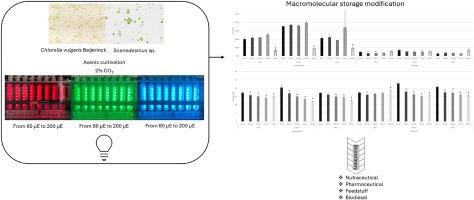在小球藻和小球藻中最大限度地提高高价值生物量:探索用于营养和饲料应用的光驱动大分子储存
IF 5.8
2区 生物学
Q1 AGRICULTURAL ENGINEERING
引用次数: 0
摘要
在制药、食品和饲料行业使用微藻生物质的严格安全要求需要加强科学研究,以确定在无菌环境下的最佳培养条件。为了实现高生物量产量和大分子生产力,必须系统地评估各种栽培参数。特别是,菌株对这些条件的特异性反应强调了理解无机碳供应和光照如何影响生物量增殖和大分子积累的重要性。为了更深入地了解微藻产量,在2% CO2供应的无菌条件下培养了Scenedesmus sp.和Chlorella sp.。研究了不同光波长(红、绿、蓝)和光强(80 μE ~ 200 μE)对光的影响。在200 μE的红光、绿光和蓝光照射下,Scenedesmus sp.的生物量产量最高,分别为0.78±0.12 gL-1、0.94±0.07 gL-1和1.00±0.10 gL-1。150 μE的红光、绿光和蓝光使脂肪储存量分别达到25.32±1.50%、39.36±1.81%和33.91±19.87%。而在100 μE的红、绿、蓝光照射下,小球藻生物量保持稳定,分别产生0.65±0.04 g L−1、0.66±0.09 g L−1和0.66±0.07 g L−1。增加光照强度对脂质储存无显著影响,保持在6.87%。在所有实验条件下,两种微藻菌株的蛋白质含量一致,均超过15%。脂质特征显示出高浓度的油酸、棕榈酸、硬脂酸和异丙酸,突出了将这些微藻菌株整合到制药、营养保健和饲料工业中的潜力。本文章由计算机程序翻译,如有差异,请以英文原文为准。

Maximizing high-value biomass in Scenedesmus and Chlorella: Exploring light-driven macromolecular storage for nutraceutical and feed applications
The stringent safety requirements for using microalgal biomass in the pharmaceutical, food, and feed industries demand increased scientific research to identify optimal cultivation conditions under axenic environments. To achieve high biomass yields and macromolecular productivity, various cultivation parameters must be systematically evaluated. In particular, the strain-specific responses to these conditions underscore the importance of understanding how inorganic carbon supply and light irradiation influence biomass proliferation and macromolecular accumulation. To gain deeper insight into microalgae productivity, Scenedesmus sp. and Chlorella sp. were cultivated under axenic condition with a 2 % CO2 supply. The effects of different light wavelengths (red, green and blue) and light intensities (ranging from 80 μE to 200 μE) were investigated. The highest biomass production for Scenedesmus sp. was observed under red, green, and blue light at an intensity of 200 μE, yielding 0.78 ± 0.12 gL-1, 0.94 ± 0.07 g L−1, and 1.00 ± 0.10 g L−1, respectively. Red, green, and blue light at 150 μE intensity increased lipid storage to 25.32 ± 1.50 %, 39.36 ± 1.81 %, and 33.91 ± 19.87 %, respectively. In contrast, the biomass of Chlorella remained stable under 100 μE of red, green, and blue light, producing 0.65 ± 0.04 g L−1, 0.66 ± 0.09 g L−1, and 0.66 ± 0.07 g L−1, respectively. Increasing light intensity did not significantly affect lipid storage, which remained at 6.87 %. Protein content was consistent in both microalgae strains across all experimental conditions, exceeding 15 %. Lipid characterization revealed a high concentration of oleic, palmitic, stearic, and vaccenic acids, highlighting the potential for integrating these microalgae strains into the pharmaceutical, nutraceutical and feed industries.
求助全文
通过发布文献求助,成功后即可免费获取论文全文。
去求助
来源期刊

Biomass & Bioenergy
工程技术-能源与燃料
CiteScore
11.50
自引率
3.30%
发文量
258
审稿时长
60 days
期刊介绍:
Biomass & Bioenergy is an international journal publishing original research papers and short communications, review articles and case studies on biological resources, chemical and biological processes, and biomass products for new renewable sources of energy and materials.
The scope of the journal extends to the environmental, management and economic aspects of biomass and bioenergy.
Key areas covered by the journal:
• Biomass: sources, energy crop production processes, genetic improvements, composition. Please note that research on these biomass subjects must be linked directly to bioenergy generation.
• Biological Residues: residues/rests from agricultural production, forestry and plantations (palm, sugar etc), processing industries, and municipal sources (MSW). Papers on the use of biomass residues through innovative processes/technological novelty and/or consideration of feedstock/system sustainability (or unsustainability) are welcomed. However waste treatment processes and pollution control or mitigation which are only tangentially related to bioenergy are not in the scope of the journal, as they are more suited to publications in the environmental arena. Papers that describe conventional waste streams (ie well described in existing literature) that do not empirically address ''new'' added value from the process are not suitable for submission to the journal.
• Bioenergy Processes: fermentations, thermochemical conversions, liquid and gaseous fuels, and petrochemical substitutes
• Bioenergy Utilization: direct combustion, gasification, electricity production, chemical processes, and by-product remediation
• Biomass and the Environment: carbon cycle, the net energy efficiency of bioenergy systems, assessment of sustainability, and biodiversity issues.
 求助内容:
求助内容: 应助结果提醒方式:
应助结果提醒方式:


